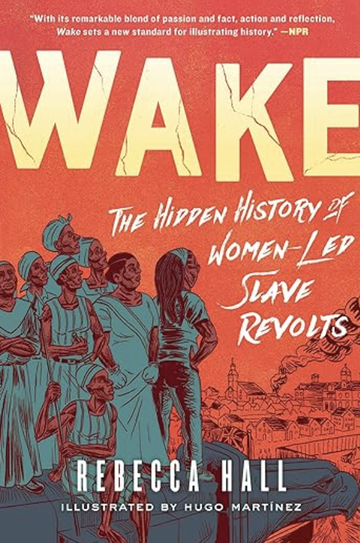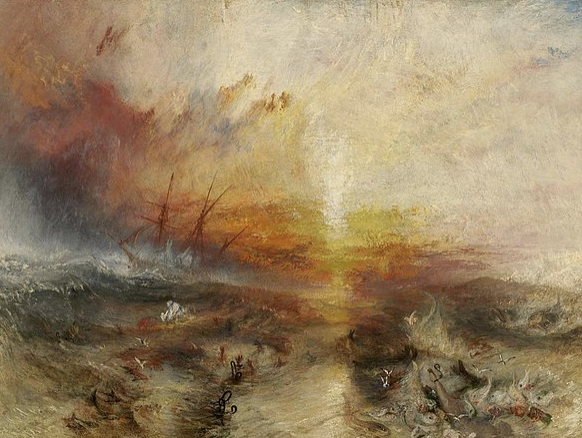Review of "Wake"by Rebecca HallApproximately 50 million Africans were taken from Africa to Europe and the Americas, and it is known that at least 30% to as many as 50% of them died during the migration. The importation of black people from Africa as slaves lasted for about 400 years from the 15th century to the 19th century, and Africans were turned into slaves solely because they lived in Africa and became commodities for white people. William Turner (1775-1851), a “master landscape painter,” originally titled this painting “Slavers Throwing the Dead and the Dead into the Sea - The Storm’s Invasion.” Turner drew a picture of an incident he read about at the time, and the details of the incident that led to the fire are as follows. In 1783, an epidemic broke out on a Korean-British cargo ship sailing to the New World carrying hundreds of slaves from Africa. As the slaves were dying from fever and a storm hit, the captain threw the dead and sick slaves into the sea. This is because slaves were covered by marine insurance, but they were not covered by insurance when they got sick. In other words, the act of abandoning cargo and protecting the ship in a crisis situation such as a storm is called “cargo abandonment” and is subject to insurance payment, but the sick “cargo” was covered by insurance. This is because there is no compensation for . After returning to England, the slave trader received 30 pounds of insurance for each piece of cargo he threw into the sea. Mutinies occurred frequently on slave ships coming from Africa to Europe or the Americas, but nearly 50% of shipboard mutinies are unknown history. It is said that the higher the proportion of women among the black people on board the ship, the higher the likelihood of mutiny. It is said that when white people put black people on a boat, the black men were locked in a narrow space under the boat, but the women and children were kept on the boat and were not tied down. This is because relatively free women secretly went under the ship and rescued black people. Dr. Rebecca Hall began her study of history while working as a lawyer. She followed the traces of black slaves, especially female slaves, and explored slave revolts and human rights as women. The female-led slave rebellion covered in this book is ◎ In January 1707, in New York City, landowner William Hallett II, his wife, and five children were murdered by the house's slaves, an Indian man and a Negro woman. ◎ 1712 slave rebellion that killed residents in New York City, ◎ This is a mutiny that took place on the slave ship Unity crossing the Atlantic in June 1770. The Negro woman was also called the 'Negro devil' and her name is nowhere to be found. Although the 1707 incident was a decisive moment in the creation of the law that laid the foundation for slave control methods, few records remained. Seven white people were murdered and four slaves were executed, but there was no trace in the historical records. This is a passage that once again confirms how miserable the human rights situation for black women was at that time. I can't believe that humans can be so cruel to others. When we deal with black history, we initially try to forget the horrors of the past. Trying to ignore it. Pretend it never happened. The next step is to acknowledge the past and the harm it has done. Even though it may come as a shock. We try not to look too closely. When we integrate the past as part of who we are, we reach the final step in overcoming trauma. The past becomes a part of us that we recognize and the basis for understanding our world. The past is not a ghost that we can drive away or shake off. It's something we have to internalize. Author Rebecca Hall asked, 'What made women rise up at a specific time and place?' during the slave rebellion. She was curious about this. But she could never find it in their records. Even though there were more revolts where there were more women, the men ignored them. It was dismissed as a coincidence. Women were viewed as beings who could commit murder out of ‘emotion’ but could not plan or lead a rebellion. Therefore, the subjectivity of female slaves, both slaves and women, was rarely preserved in the records of the victors. Wake, a graphic novel and memoir, is an imaginative masterpiece that tells the story of a female-led slave rebellion and chronicler Rebecca Hall's efforts to uncover the truth about hitherto marginalized female warriors. Female warriors planned and led slave revolts on slave ships during the Middle Passage. They fought slaves throughout the Americas. And they were erased from history. The author of this book is also a historian, the granddaughter of a slave, and a woman suffering from the legacy of slavery. Her history of slave revolts has always told her that slave women took a backseat. But Rebecca decides to look deeper, and her journey takes her through old court records, a slave ship captain's log, broken correspondence, and even forensic evidence from the bones of an enslaved woman discovered in a "negro burial ground" in Manhattan. She discovers female warriors everywhere. Through in-depth archival research and judicious use of the historical imagination, Rebecca constructs the story of the women who led slave revolts in colonial New York, as well as the possible past of Adorno and Alele, female rebels who fought for freedom in the Middle Passage. . We also follow Rebecca through her own story, with the legacy of slavery both in her days as a successful lawyer and later in her life as a historian who explores her past as it continues to haunt her. It forms. Beautifully illustrated in black and white, Wake is a powerful reminder that the past may be gone, but we still live in its traces. Through her writing, she lets us know that trauma is not something that can be erased but something that can be overcome. And there are black artists, such as Dr. Rebecca Hall, who use their black identity to show messages about their rights as human beings.
Bisa Butler is an artist who creates quilts so detailed they look like paintings. American artist Bisa Butler highlights African traditions through fun and colorful plush collages. Portraits of women, men, couples, children, and the elderly are Butler's primary source material, and it is through his work that we are all human, regardless of skin color. Whether in Rebecca Hall's black-and-white graphic novels or Bisa Butler's colorful fabric artworks, we discover the noble dignity and identity of being a human being before dividing white and black. I think this is the truth we should always remember when learning history and living reality.
0 Comments
Leave a Reply. |
Myungja Anna KohArtist Categories
All
Archives
July 2024
|
Proudly powered by Weebly




 RSS Feed
RSS Feed